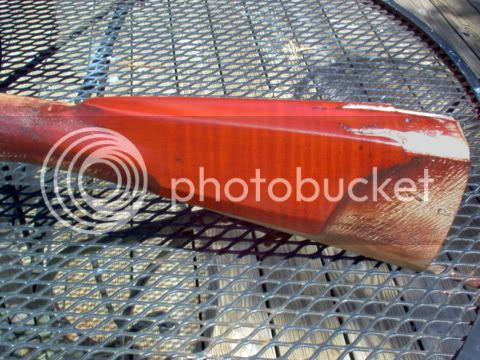Actually, the colored varnish is best mixed up at the time of use.
I have been using my own boiled linseed oil varnish that I made. I don't really have enough made up right now to sell any. The recipe goes as follows: get one deep fryer thing with a closed element (little or no risk of flame up), get one that will go as hot as possible with a manual heat control. Put in 1 pt. of "store bought" "Boiled" linseed oil and boil it for about 2 hours at a slow rolling boil. Put 6 oz of Rosin in a glass container and pour in about a cup of turpentine and let it sit and soften up while the oil is boiling. Add it to the oil when desired and boil it a bit more. Now, I have been adding about a teaspoon or less of lead carbonate as the drier. On my next varnish making project, I am going to use raw linseed oil and no lead carbonate. It should work out perfectly fine and be totally non toxic to boot. Anyway, when finished boiling, let it sit a while to cool off some (though you still want it warm, but not hot) then pour it into glass mason jars and that's it. This makes a "plain brown varnish". You can substitute some Mastic for the rosin, or some sandarac. Both were common resins used. I have made varnish with 4 oz of rosin and 2 oz of mastic before. I don't know if it really makes any difference. Rosin is cheap enough.
The coloring can be done with any oil type of varnish, I suppose, but they may or may not behave correctly when applying the "paint", that is, a lot of modern varnishes get tacky too quickly. I rub the varnish on the stock very thinly with my hand. You can get the pigments from
[url] www.Kremer-pigmente.de[/url] They only cost a few dollars. Their American office and store is in NYC. You WILL need a "muller"...a glass pestle type thing and a marble plate. Kremer has a nice muller. It's about 48 bucks, but you have to have one to do this. They also have good instructions on mulling paint. You basically put a small amount of pigment on the marble slab, add a small amount of oil and grind the oil into the pigment.
Oh, yes, very important, Linseed oil varnishes absolutely, positively, NEED sunlight to dry. It will dry in a few hours in the sun, whereas it could sit in a warm dry room for YEARS and not dry!!!
You can get synthetic alizarin, but the colors are too bright. They also have real madder, but it is expensive. You can, of course, "precipitate" out your own natural alizarin from madder roots, but I haven't cared to delve that deeply just yet...
There was a historically used transparent red earth pigment which is no longer generally available. The modern substitute is a transparent red iron oxide (which is essentially the same thing, only arrived at synthetically). This is the one I think looks best, and is a nice brownish red color. Not as
"RED!!!" as the varnish on the stock above. There is a different natural transparent red earth still available. I can't remember exactly what it is....English transparent burnt sienna? This one is more brown though.
There are also transparent browns and yellows, both were used in violin varnishes as well. Again, just make SURE you are getting transparent pigments, otherwise, you're just making plain paint.
There also are colored spirit varnishes, but I have never cared to use a spirit varnish as a top coat. They are easier to color, however. Look up "violin varnish" on the internet, and you will find an immense amount of information.
You can see also on the stock above that the curl shows through the "paint" quite nicely, even though the curl on this stock is not that "strong". The color does not really hide the grain much, if at all.
Oh, yes, another thing, don't try to fill the grain with the colored varnish. Trust me, it doesn't look good! It doesn't impart any appreciable amount of color to the stock, plus, it fills the pores with red specks which you can definitely see. NOT attractive.









